A Selective Fault Clearing Scheme for a Hybrid VSC-LCC Multi-Terminal HVdc System
Abstract
1. Introduction
- De-energize all VSC rectifiers by opening their ac CBs to avoid fault current injection from the ac side,
- Apply force retardation at the LCC rectifier,
- Open the fast mechanical switches when the current through them are sufficiently small.
2. Proposed Protection Scheme
2.1. Key Components and Grid Layout
- For both temporary and permanent faults on VSC branches, they avoid the impact on the LCC link by promptly disconnecting faulty conductor(s) from the main LCC link.
- For temporary faults on the main LCC link, they avoid the need for a complete shutdown and restarting of VSC stations by promptly disconnecting faulty conductor(s) from the VSCs. The VSCs that are connected to faulty pole(s) could be switched to static synchronous compensator (STATCOM) mode (i.e., no real power transfer) until the fault on the main transmission line is cleared.
- Because there is no alternative path for power transfer during a VSC branch fault in the considered layout, isolation of the faulty conductor to preserve the continuity of VSC operation does not offer any significant advantage.
- Each VSC has its own low-level protection such as IGBT blocking upon fault detection and freewheeling diode protection by firing parallel thyristors [25].
2.2. DC Side Fault Clearing Strategy
2.3. Fault Discrimination Strategy
3. Test System Parameters and Settings
3.1. Test System
3.2. Protection Settings
4. Results
4.1. Fault Discrimination
4.2. Clearing Temporary Faults on the Main Line
4.2.1. Pole-to-Pole Faults
4.2.2. Pole-to-Ground Faults
4.3. Clearing Temporary Faults on a VSC Branch
4.3.1. Pole-to-Pole Faults
4.3.2. Pole-to-Ground Faults
4.4. Fault Recovery Delays, Fault Detection Speed, and Breaker Rating
5. Conclusions
Author Contributions
Funding
Conflicts of Interest
References
- Haleem, N.M.; Rajapakse, A.D.; Gole, A.M.; Fernando, I.T. Investigation of Fault Ride-Through Capability of Hybrid VSC-LCC Multi-Terminal HVdc Transmission Systems. IEEE Trans. Power Deliv. 2019, 34, 241–250. [Google Scholar] [CrossRef]
- Flourentzou, N.; Agelidis, V.G.; Demetriades, G.D. VSC-based HVdc power transmission systems: An overview. IEEE Trans. Power Electron. 2009, 24, 592–602. [Google Scholar] [CrossRef]
- Tang, G.; Xu, Z. A LCC and MMC hybrid HVdc topology with DC line fault clearance capability. Int. J. Electr. Power Energy Syst. 2014, 62, 419–428. [Google Scholar] [CrossRef]
- Hahn, C.; Geuß, A.; Luther, M. Modeling and control design of hybrid—LCC and VSC based—HVdc systems. In Proceedings of the IEEE/PES Transmission and Distribution Conference and Exposition (T&D), Dallas, TX, USA, 2–5 May 2016. [Google Scholar]
- Nguyen, M.H.; Saha, T.K.; Eghbal, M. Hybrid multi-terminal LCC HVdc with a VSC Converter: A case study of Simplified South East Australian system. In Proceedings of the IEEE Power and Energy System General Meeting, San Diego, CA, USA, 22–26 July 2012. [Google Scholar]
- Naushath, M.H.; Rajapakse, A.D.; Gole, A.M.; Fernando, I.T. Energization and regulation of a hybrid HVdc grid with LCC and VSC. In Proceedings of the IEEE Electric Power and Energy Conference, Saskatoon, SK, Canada, 22–25 October 2017. [Google Scholar]
- Liao, J.; Zhou, N.; Wang, Q.; Luo, Y. A Bypass LCC-Based dc Fault Isolation Scheme for Bipolar MMC–HVdc. IEEE Access 2019, 7, 118218–118228. [Google Scholar]
- Lin, W.; Wen, J.; Yao, M.; Wang, S.; Cheng, S.; Li, N. Series VSC-LCC converter with self-commutating and dc fault blocking capabilities. In Proceedings of the IEEE PES General Meeting, National Harbor, MD, USA, 27–31 July 2014. [Google Scholar]
- Rao, H.; Zhou, Y.; Xu, S.; Cai, X.; Cao, W.; Xu, Y.; Ren, C. Key technologies of ultra-high voltage hybrid LCC-VSC MTdc systems. CSEE J. Power Energy 2019, 5, 365–373. [Google Scholar] [CrossRef]
- Lee, Y.; Cui, S.; Kim, S.; Sul, S.K. Control of hybrid HVdc transmission system with LCC and FB-MMC. In Proceedings of the IEEE Energy Conversion Congress and Exposition, Pittsburgh, PA, USA, 14–18 September 2014. [Google Scholar]
- Torres, O.R.E.; Molinas, M.; Undeland, T. Hybrid HVDC connection of large offshore wind farms to the AC grid. In Proceedings of the IEEE International Symposium on Industrial Electronics, Hangzhou, China, 28–31 May 2012. [Google Scholar]
- Pan, W.; Chang, Y.; Chen, H. Hybrid Multi-terminal HVdc System for Large Scale Wind Power. In Proceedings of the IEEE PES Power Systems Conference and Exposition, Atlanta, GA, USA, 29 October–1 November 2006. [Google Scholar]
- Jung, J.; Cui, S.; Lee, J.; Sul, S. A New Topology of Multilevel VSC Converter for a Hybrid HVdc Transmission System. IEEE Trans. Power Electron. 2017, 32, 4199–4209. [Google Scholar] [CrossRef]
- Li, G.; Liang, J.; Joseph, T.; An, T.; Lu, J.; Szechtman, M.; Andersen, B.R.; Zhuang, Q. Feasibility and Reliability Analysis of LCC dc Grids and LCC/VSC Hybrid dc Grids. IEEE Access 2019, 7, 22445–22456. [Google Scholar] [CrossRef]
- Xu, D.; Zhao, X.; Lu, Y.; Qin, K.; Guo, L. Study on overvoltage of hybrid LCC-VSC-HVdc transmission. J. Eng. 2019, 16, 1906–1910. [Google Scholar] [CrossRef]
- Howell, S.; Filizadeh, S.; Gole, A.M. Unidirectional HVdc topology with dc fault ride-through capability. Can. J. Electr. Comput. Eng. 2017, 40, 41–49. [Google Scholar]
- Annakkage, U. Hybrid LCC and Multi-terminal Full-Bridge Modular Multi-Level Converters for HVdc Transmission. Master’s Thesis, University of Toronto, Toronto, ON, Canada, 2015. [Google Scholar]
- Torres, O.R.E.; Molinas, M.; Undeland, T. Offshore Wind Farm Grid Integration by VSC Technology With LCC-Based HVdc Transmission. IEEE Trans. Sustain. Energy 2012, 3, 899–907. [Google Scholar] [CrossRef]
- Nguyen, M.H.; Saha, T.K.; Eghbal, M. Investigation on the impact of hybrid multi-terminal HVdc system combining LCC and VSC technologies using system identification. In Proceedings of the Australasian Universities Power Engineering Conference, Bali, Indonesia, 26–29 September 2012. [Google Scholar]
- Song, J. Analysis of Hybrid LCC-VSC HVdc Transmission Systems. Master’s Thesis, Universitat Politècnica de Catalunya UPC, Barcelona, Spain, 2018. [Google Scholar]
- Xiao, L.; Li, Y.; Xiao, H.; Zhang, Z.; Xu, Z. Electromechanical Transient Modeling of Line Commutated Converter-Modular Multilevel Converter-Based Hybrid Multi-Terminal High Voltage Direct Current Transmission Systems. Energies 2018, 11, 2102. [Google Scholar] [CrossRef]
- Suriyaarachchi, D.H.R.; Karawita, C.; Mohaddes, M. Tapping existing LCC-HVdc systems with Voltage Source Converters. In Proceedings of the IEEE Power and Energy Society General Meeting, Boston, MA, USA, 17–21 July 2016. [Google Scholar]
- Li, X.; Yuan, Z.; Fu, J.; Wang, Y.; Liu, T.; Zhu, Z. Nanao multi-terminal VSC-HVdc project for integrating large-scale wind generation. In Proceedings of the IEEE Power and Energy General Meeting, National Harbor, MD, USA, 27–31 July 2014. [Google Scholar]
- Jie, Z.; Haibin, L.; Rui, X.; Wenhai, N.; Kun, S.; Feiyang, H. Research of dc circuit breaker applied on Zhoushan multi-terminal VSC-HVdc project. In Proceedings of the IEEE PES Asia-Pacific Power and Energy Engineering Conference, Xi’an, China, 25–28 October 2016. [Google Scholar]
- Li, X.; Song, Q.; Liu, W.; Rao, H.; Xu, S.; Li, L. Protection of Nonpermanent Faults on dc Overhead Lines in MMC-Based HVdc Systems. IEEE Trans. Power Deliv. 2013, 28, 483–490. [Google Scholar] [CrossRef]
- Häfner, J.; Jacobson, B. Proactive Hybrid HVDC breakers—A key innovation for Reliable HVdc grid. In Proceedings of the CIGRE Symposium, Bologna, Italy, 13–15 September 2011. [Google Scholar]
- Sneath, J.; Rajapakse, A.D. Fault Detection and Interruption in an Earthed HVdc Grid Using ROCOV and Hybrid DC Breakers. IEEE Trans. Power Deliv. 2016, 31, 973–981. [Google Scholar] [CrossRef]
- Li, R.; Xu, L.; Yao, L. DC Fault Detection and Location in Meshed Multiterminal HVdc Systems Based on DC Reactor Voltage Change Rate. IEEE Trans. Power Deliv. 2017, 32, 1516–1526. [Google Scholar] [CrossRef]
- Sneath, J.; Rajapakse, A.D. DC Fault Protection of a Nine-Terminal MMC HVdc Grid. In Proceedings of the IET International Conference on AC and DC Power Transmission, Birmingham, UK, 10–12 February 2015. [Google Scholar]
- Nanayakkara, O.M.K.K.; Rajapakse, A.D.; Wachal, R. Location of DC Line Faults in Conventional HVdc Systems With Segments of Cables and Overhead Lines Using Terminal Measurements. IEEE Trans. Power Deliv. 2012, 27, 279–288. [Google Scholar] [CrossRef]
- Cheng, S.; Wang, Y.; Zhang, B.; Ma, H. Applicability analysis of travelling wave protection for the hybrid HVDC system. J. Eng. 2019, 16, 1730–1736. [Google Scholar] [CrossRef]
- Gao, S.; Zhu, H.; Niu, D.; Zhang, B.; Song, G. A Transient Power Protection Principle for Hybrid Bipolar DC Transmission Line Based on LCC-HVdc and VSC-HVdc. In Proceedings of the International Conference on Power System Technology, Guangzhou, China, 6–8 November 2018. [Google Scholar]
- Wang, Y.; Zhang, B. A novel hybrid directional comparison pilot protection scheme for the LCC-VSC hybrid HVdc transmission lines. In Proceedings of the 13th International Conference on Development in Power System Protection (DPSP), Edinburgh, UK, 7–10 March 2016. [Google Scholar]
- Wang, Y.; Zhang, B. Backward travelling wave-variation-based protection for the transmission line of a hybrid HVdc system. J. Eng. 2019, 2019, 1261–1265. [Google Scholar] [CrossRef]
- Wang, D.; Hou, M.; Gao, M.; Qiao, F. Travelling wave directional pilot protection for hybrid LCC-MMC-HVdc transmission line. Int. J. Electr. Power Energy Syst. 2020, 115, 105431. [Google Scholar] [CrossRef]
- Chen, X.; Li, H.; Liang, Y.; Wang, G. A protection scheme for hybrid multi-terminal HVdc networks utilizing a time-domain transient voltage based on fault-blocking converters. Int. J. Electr. Power Energy Syst. 2020, 115, 105825. [Google Scholar] [CrossRef]
- Thio, C.V. Nelson River HVdc Bipole-Two Part I—System Aspects. IEEE Trans. Power Appar. Syst. 1979, 98, 165–173. [Google Scholar] [CrossRef]
- Li, B.; He, J.; Li, Y.; Wen, W. A Novel dc CB Reclosing Strategy for the Flexible HVDC Grid. IEEE Trans. Power Deliv. 2020, 35, 244–257. [Google Scholar] [CrossRef]
- Fan, X.; Zhang, B. DC line soft reclosing sequence for HVdc grid based on hybrid dc breaker. J. Eng. 2019, 16, 1095–1099. [Google Scholar] [CrossRef]
- Li, B.; Cui, H.; Li, B.; Wen, W.; Dai, D. A permanent fault identification method for single-pole grounding fault of overhead transmission lines in VSC-HVdc grid based on fault line voltage. Int. J. Electr. Power Energy Syst. 2020, 117, 105603. [Google Scholar] [CrossRef]
- Haleem, N.M.; Rajapakse, A.D. Application of New Directional Logic to Improve dc Side Fault Discrimination for High Resistance Faults in HVDC Grids. J. Mod. Power Syst. Clean Energy 2017, 5, 560–573. [Google Scholar] [CrossRef]
- Haleem, N.M.; Rajapakse, A.D. Fault Type Discrimination in HVdc Transmission Lines Using Rate of Change of Local Currents. IEEE Trans. Power Deliv. 2020, 35, 117–129. [Google Scholar] [CrossRef]
- Zygmanowski, M.; Grzesik, B.; Nalepa, R. Capacitance and inductance selection of the modular multilevel converter. In Proceedings of the Power Electronics and Applications, Lille, France, 2–6 September 2013. [Google Scholar]
- Wang, T.; Song, G.; Hussain, K.S.T. Adaptive Single-Pole Auto-Reclosing Scheme for Hybrid MMC-HVdc Systems. IEEE Trans. Power Deliv. 2019, 34, 2194–2203. [Google Scholar] [CrossRef]
- Wang, T.; Song, G.; Wu, L.; Wei, H.; Guang, S.; Chao, L. Novel reclosure scheme of MMC-HVdc system based on characteristic signal injection. J. Eng. 2019, 16, 1153–1157. [Google Scholar] [CrossRef]
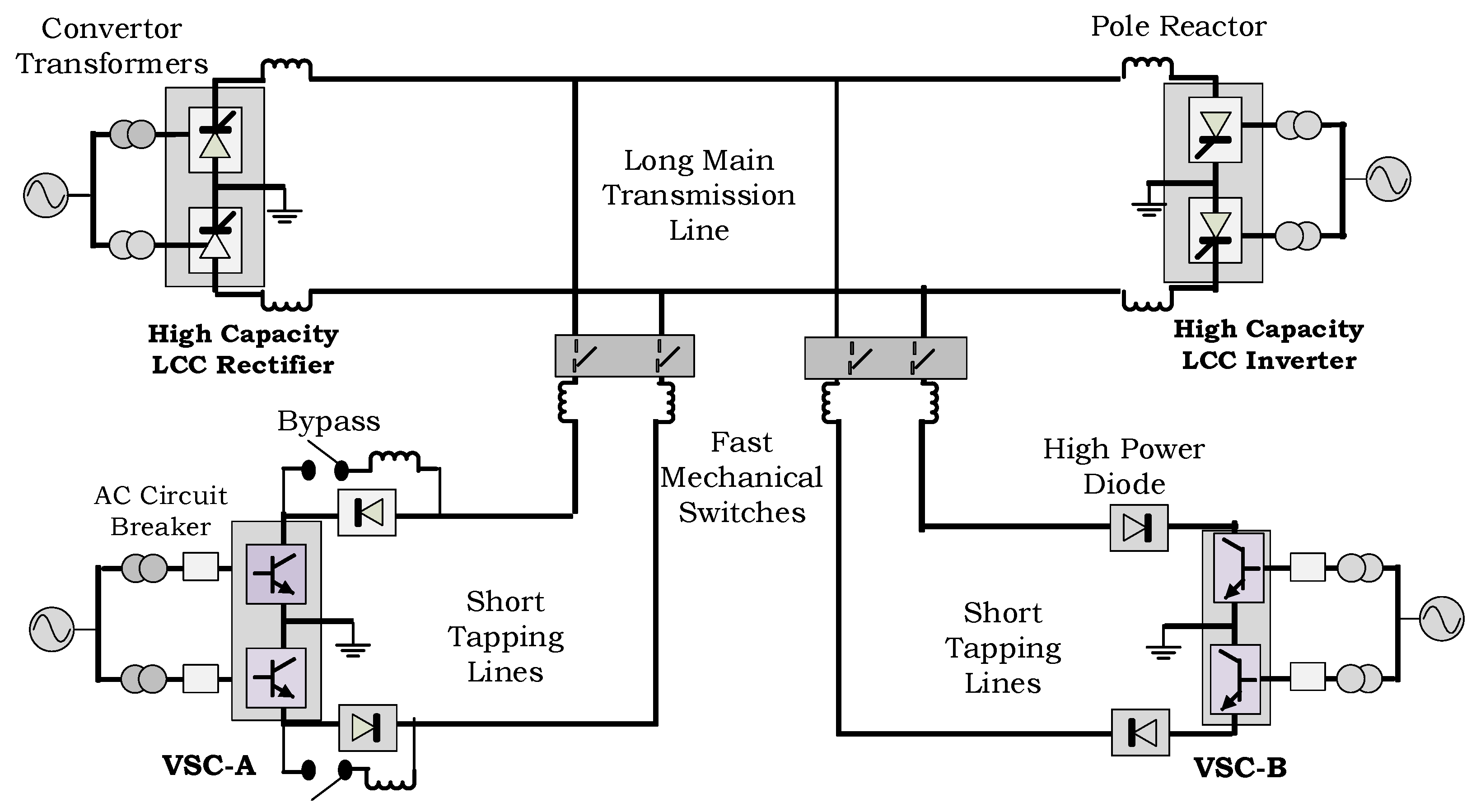
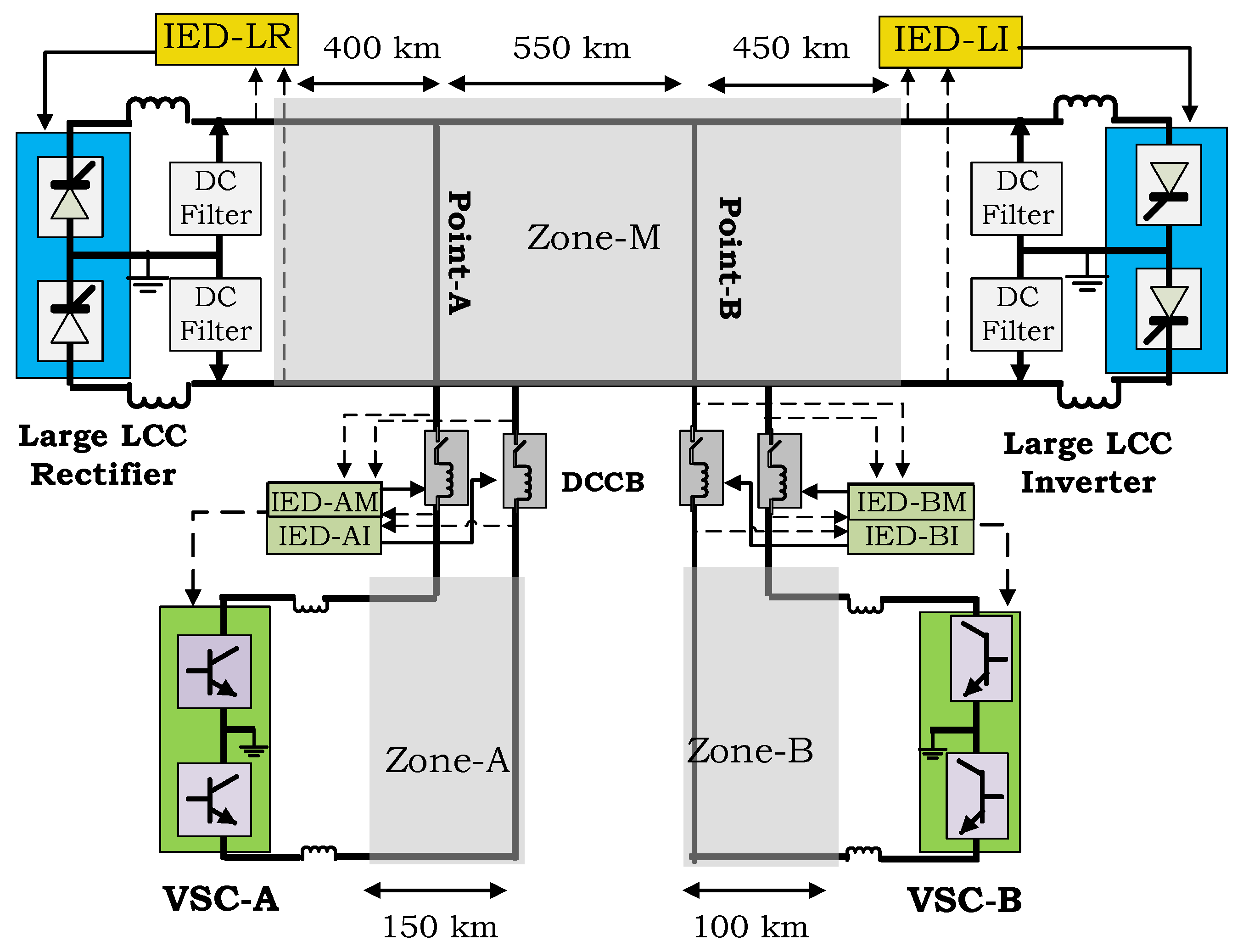



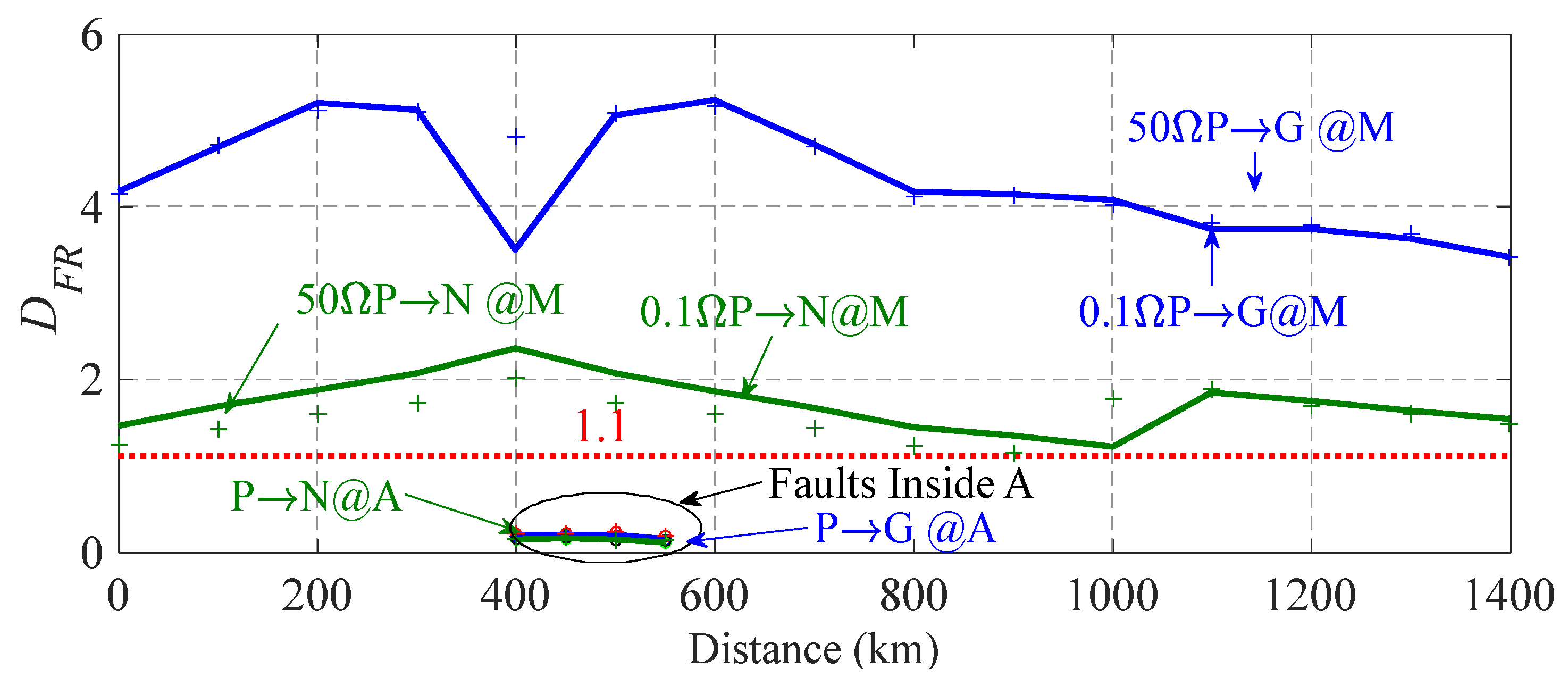
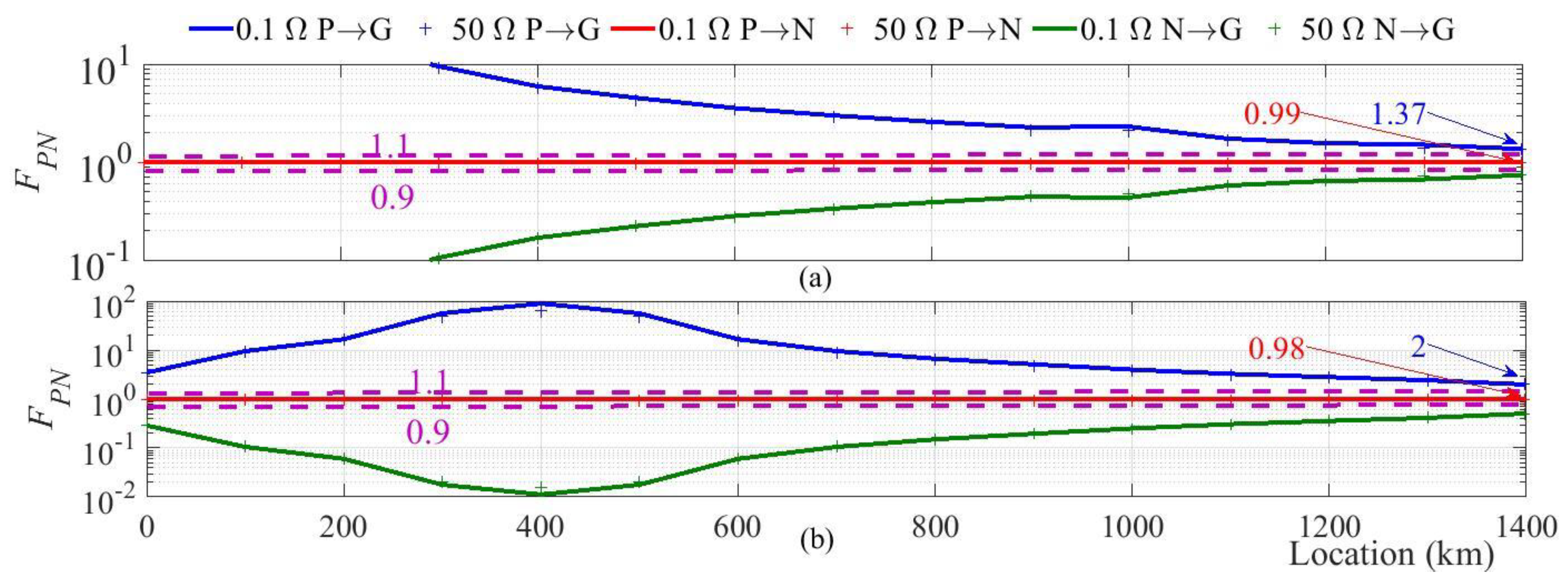
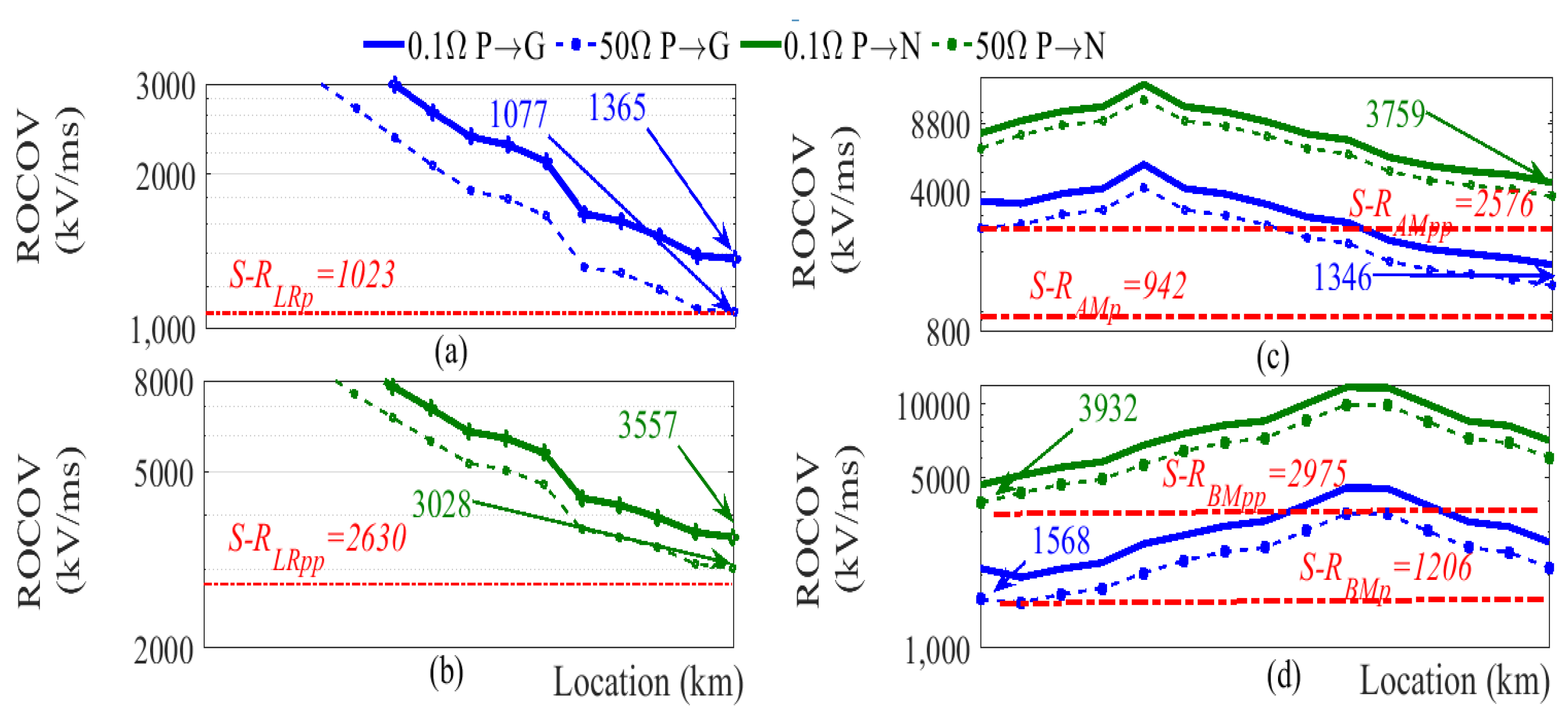
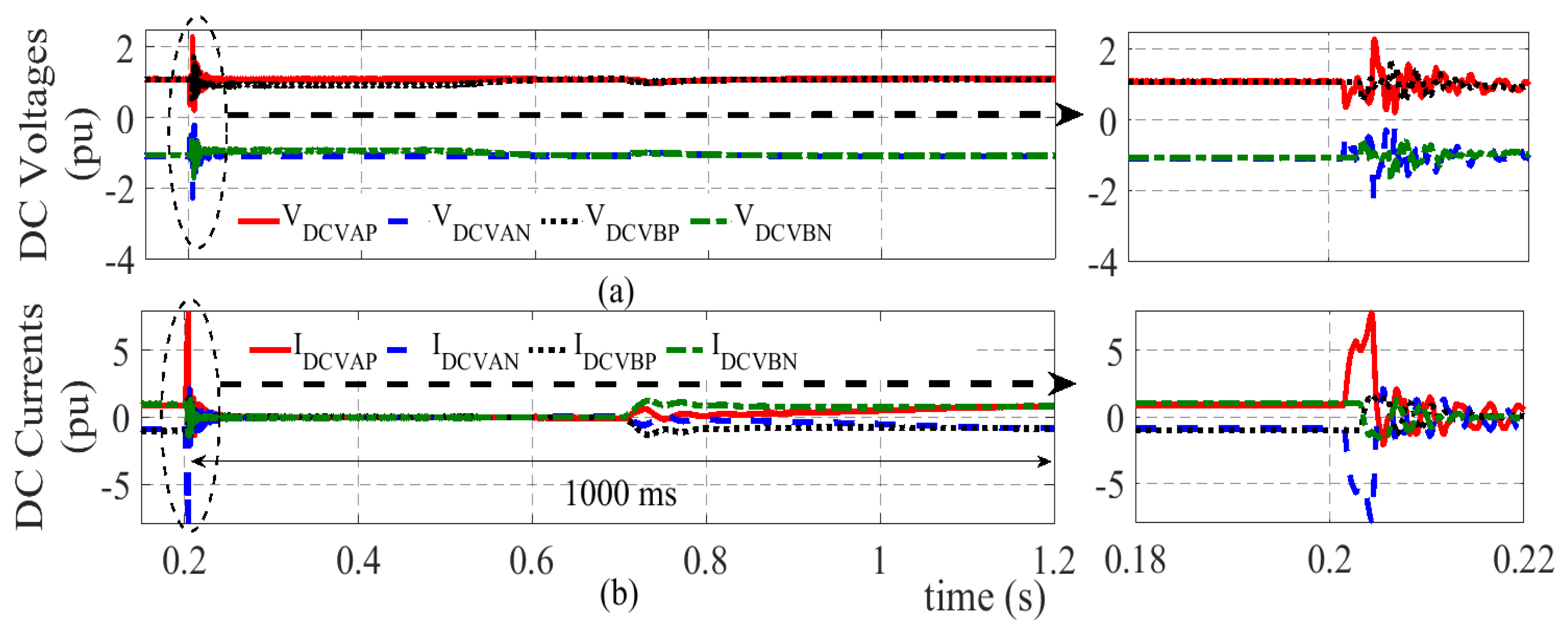

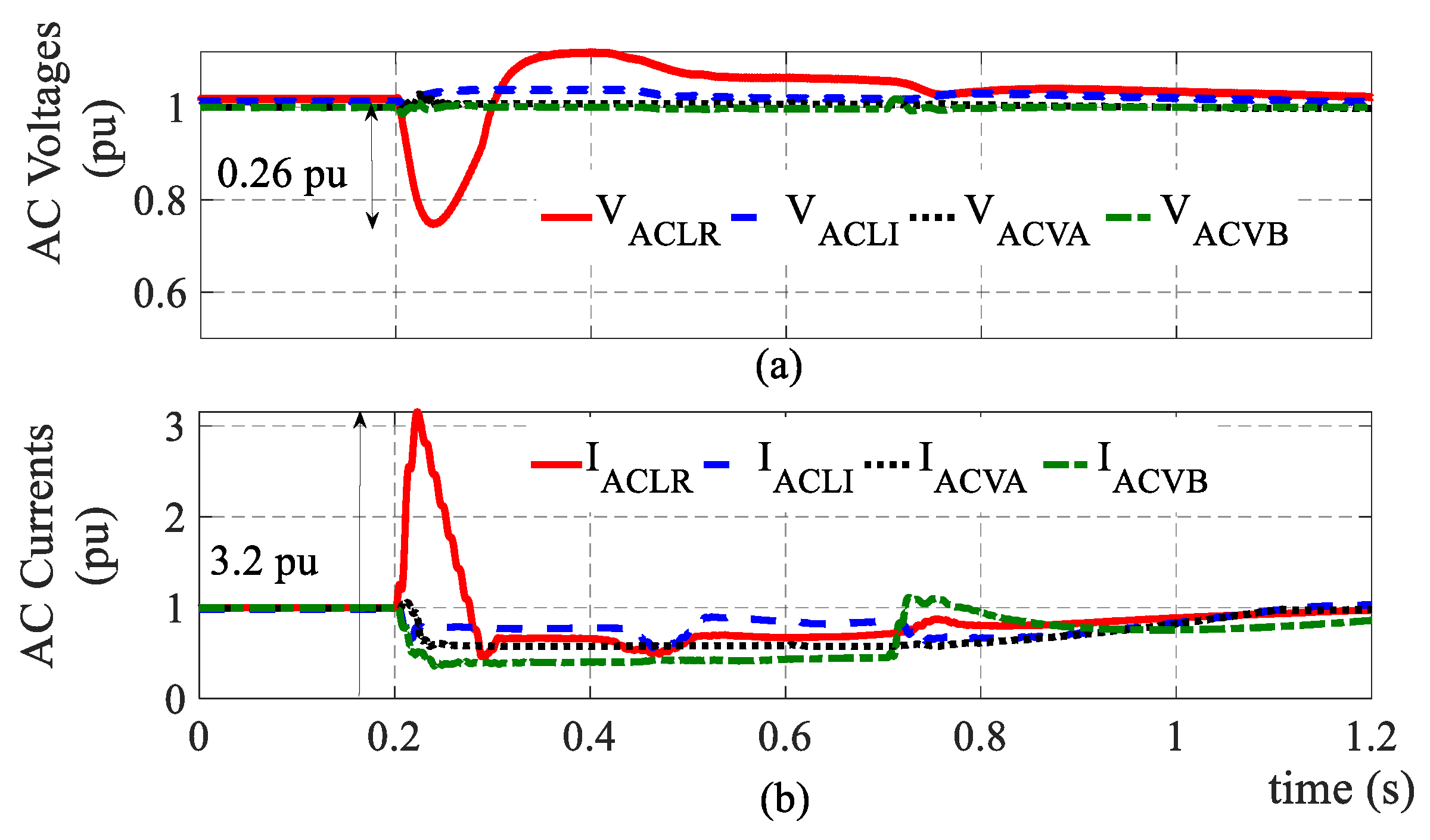
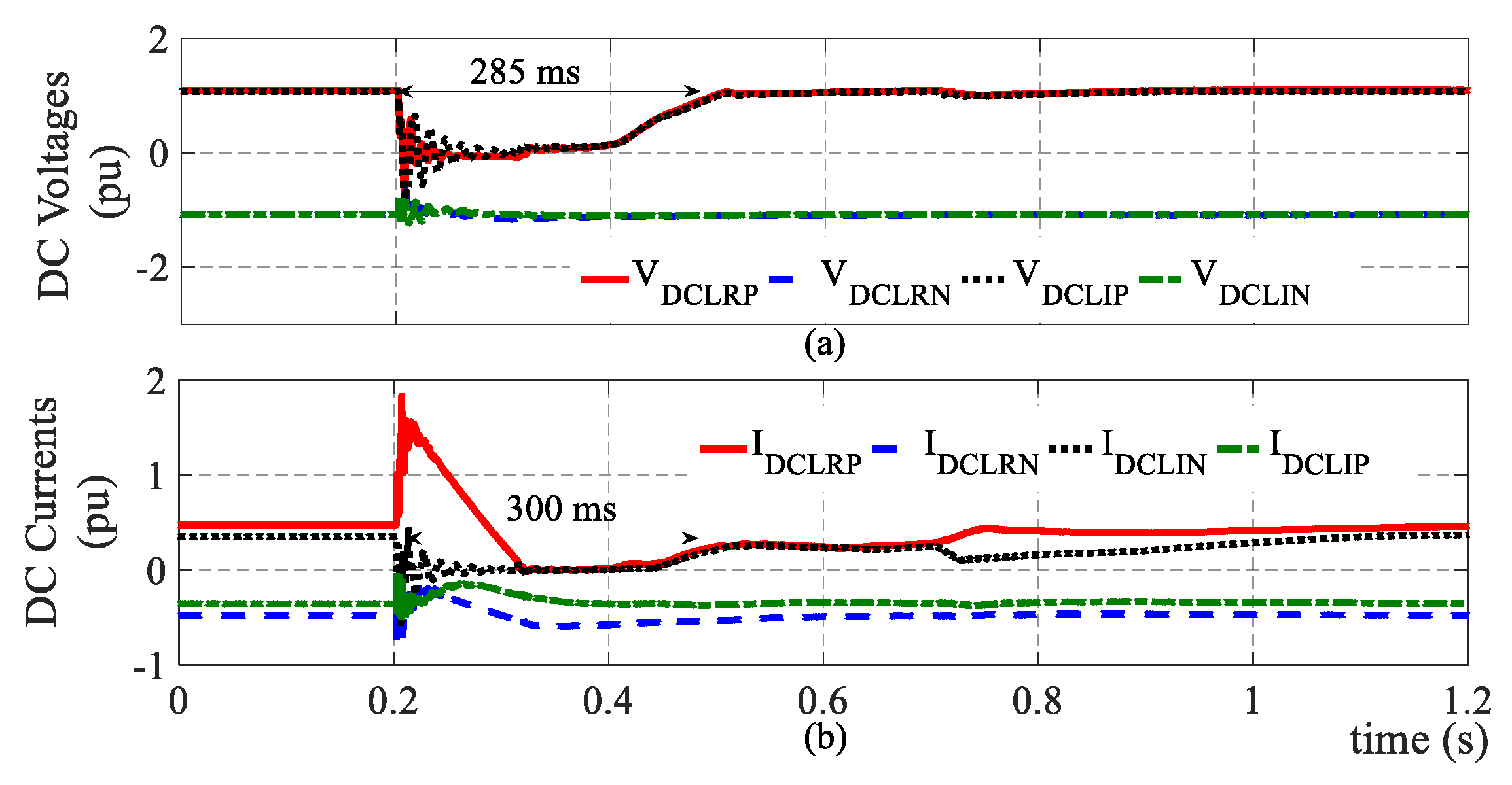
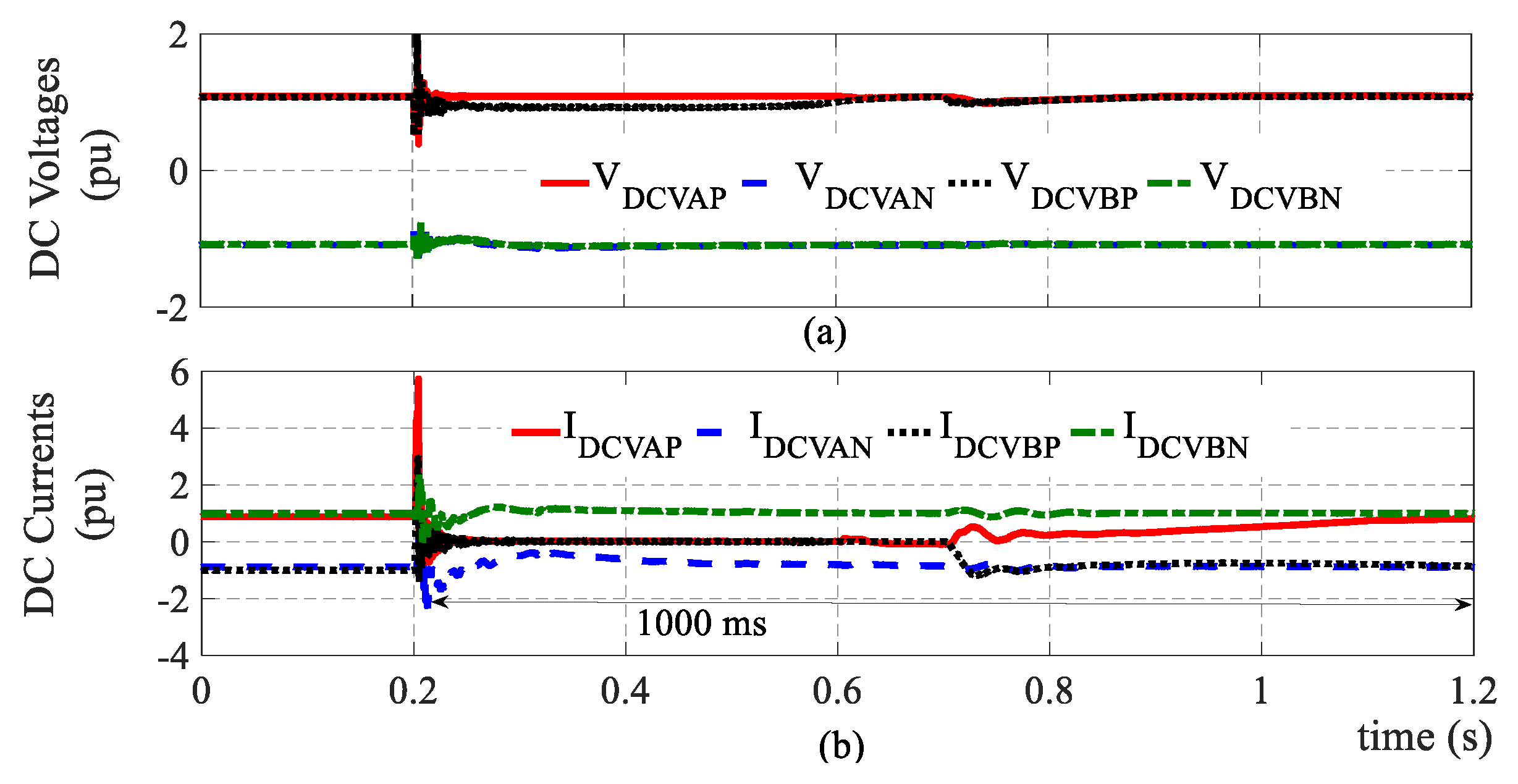
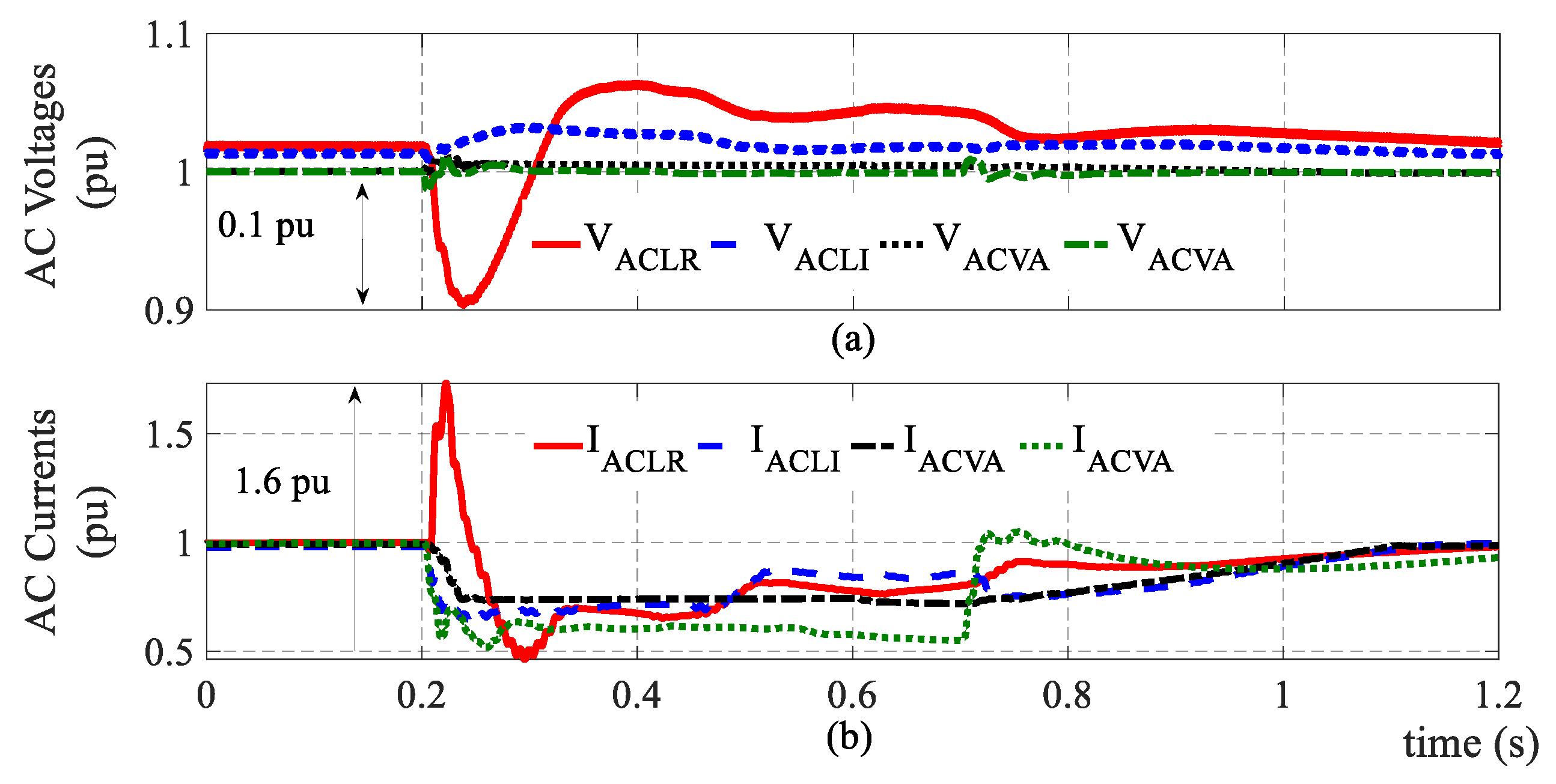

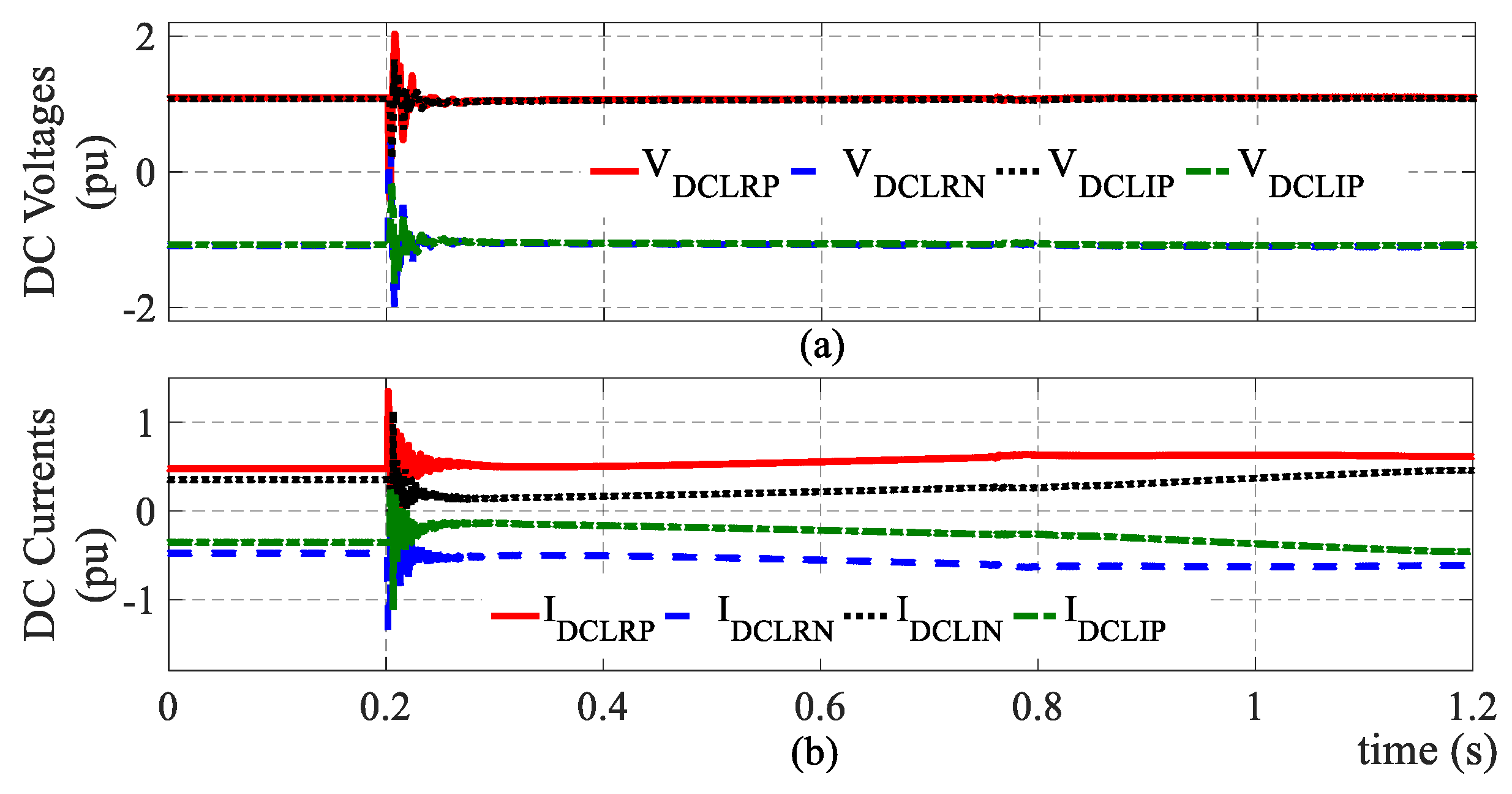
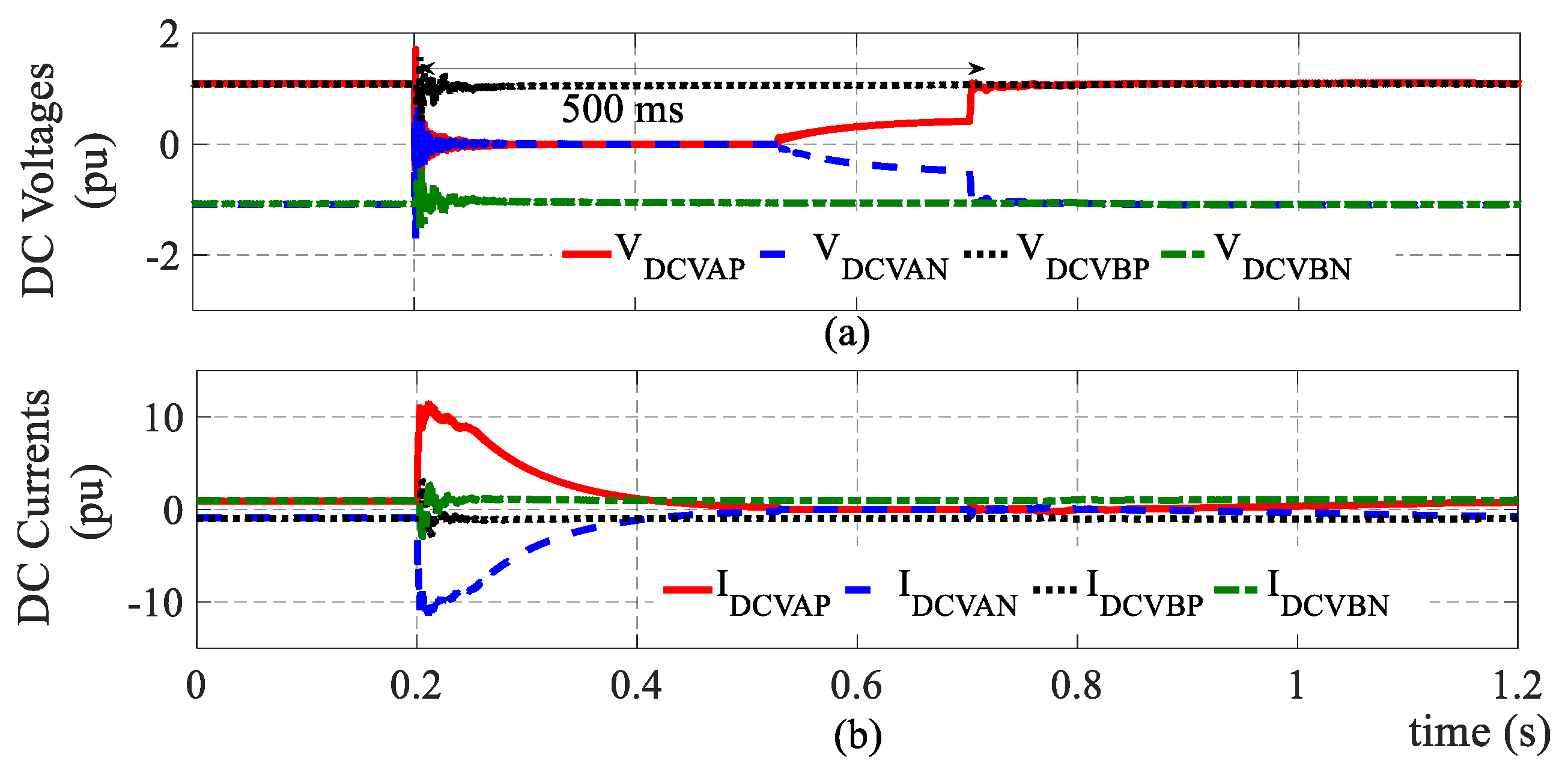
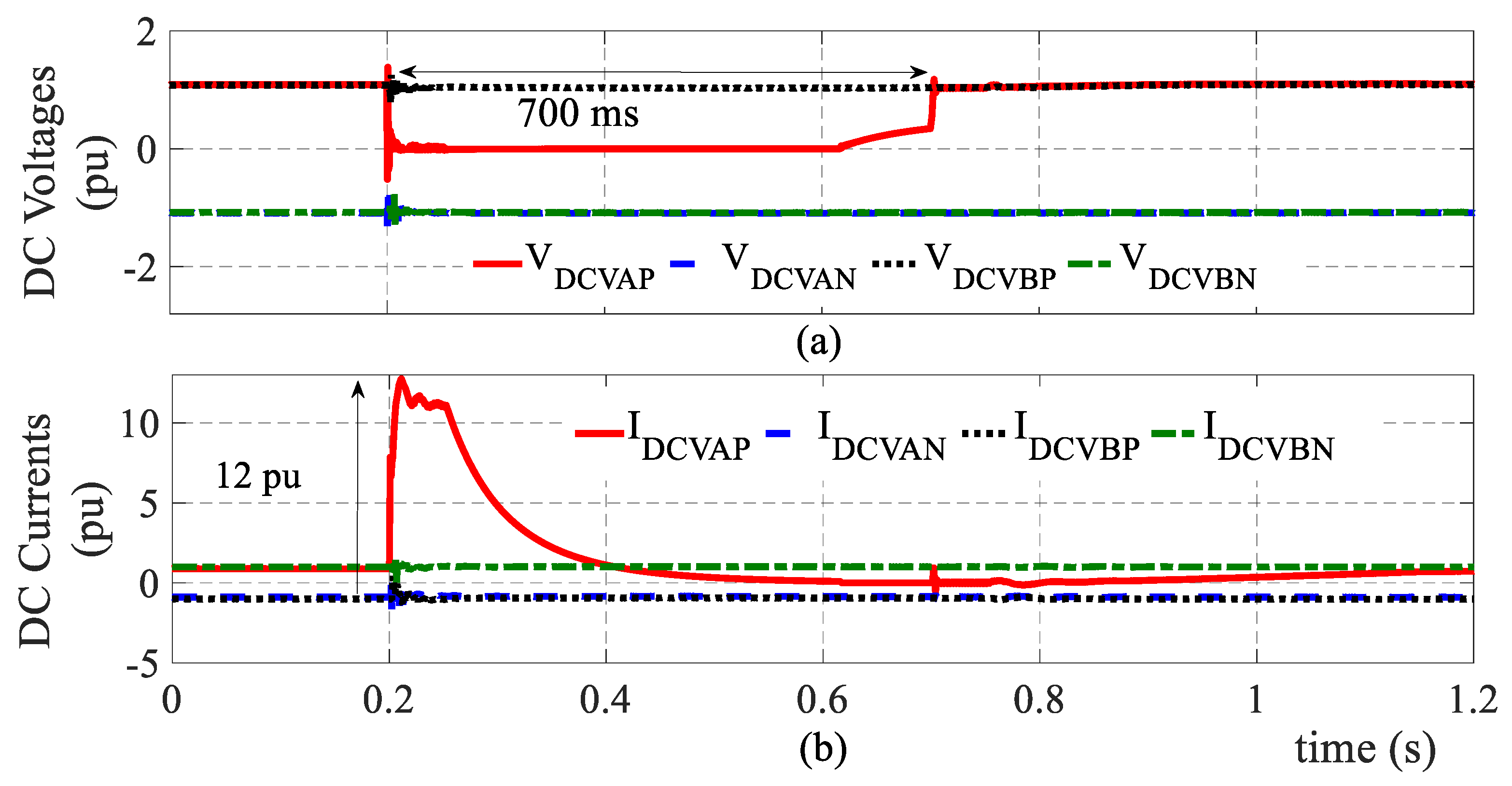
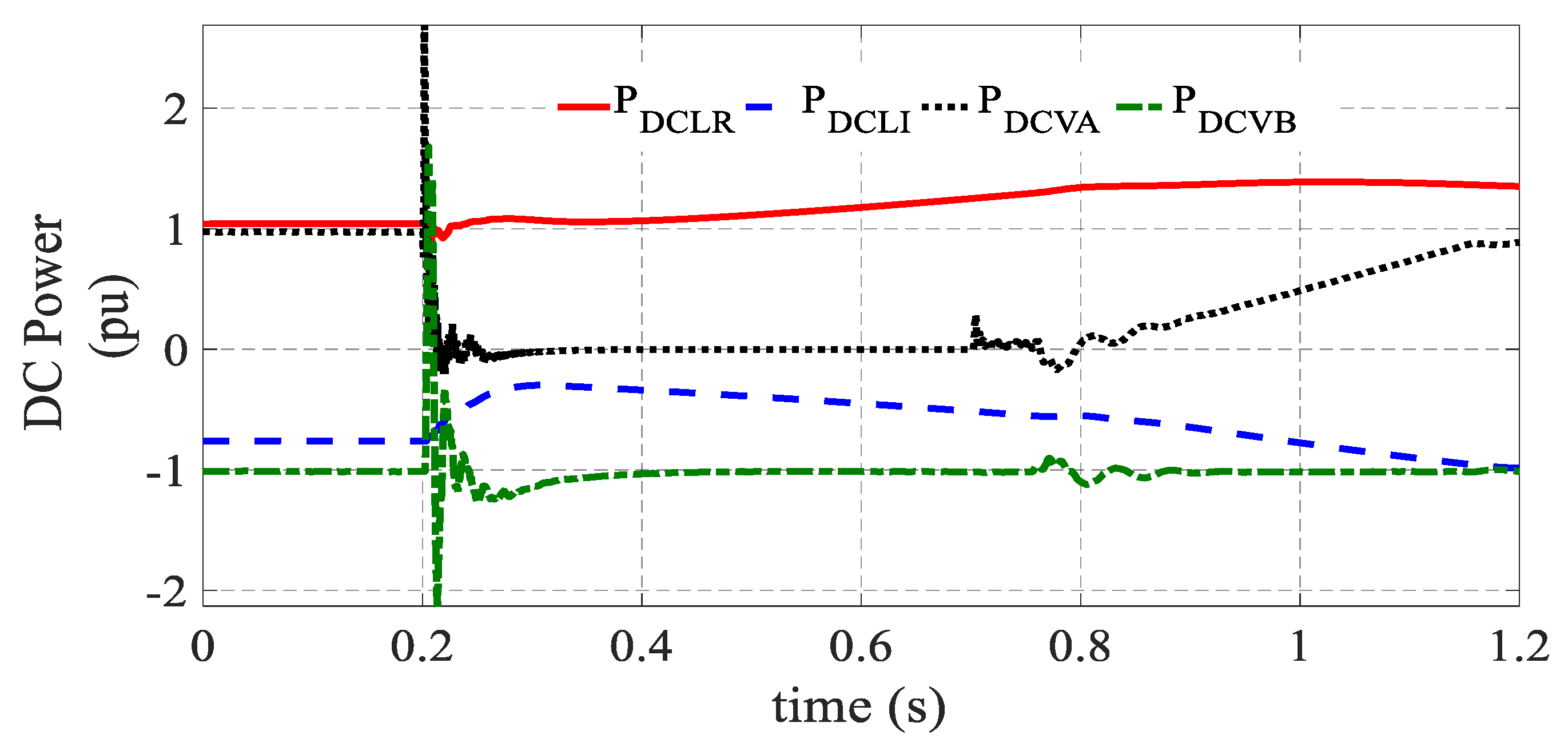

| Parameter | Value | Units |
|---|---|---|
| Nominal dc Voltage | ±500 | kV |
| ac Sys. SCR LCC-Rectifier | 2.9 | |
| ac Sys. SCR LCC-Inverter | 5.0 | |
| ac Sys. SCR VSC-A/B | 3.0 | |
| Power ramping rate in LCC during fault recovery (per pole) | 1000 | MW/s |
| Power ramping rate in VSC during fault recovery (per pole) | 300 | MW/s |
| VSC Data | ||
| MMC cell capacitance | 2000 | µF |
| MMC cell switch on resistance | 0.2 | Ω |
| Arm reactor | 25 | mH |
| Parameter | Value | Units |
|---|---|---|
| MVA-LCCs | 600 × 2 | MW/pole |
| MVA-VSC-A/B | 300 | MW/pole |
| Leakage Reactance-LCCs | 0.15 | pu |
| Leakage Reactance-VSCs | 0.1 | pu |
| Transformer Ratio LCCs | 230 kV/209 kV | |
| Transformer Ratio VSCs | 330 kV/315 kV |
| IED | (kV/ms) | (kV/ms) | (kV/ms) | (kV/ms) |
|---|---|---|---|---|
| IED-LR | 2230 | 3028 | 971 | 1077 |
| IED-LI | 1413 | 2903 | 586 | 1068 |
| IED-AM | 1394 | 3759 | 538 | 1346 |
| IED-BM | 2019 | 3932 | 875 | 1538 |
| IED | (kV/ms) | (kV/ms) | IED | (kV/ms) | (kV/ms) |
|---|---|---|---|---|---|
| IED-LR | 2630 | 1023 | IED-BM | 2975 | 1206 |
| IED-LI | 2158 | 827 | IED-AI | 8518 | 3542 |
| IED-AM | 2576 | 942 | IED-BI | 8838 | 3663 |
| Loc. (km) | Fault Type | (kV/ms) | (kV/ms) | DFR | FPN |
|---|---|---|---|---|---|
| 100 | P→G | 7393 | 5797 | 9.5 | 11.9 |
| 50 | P→G | 8518 | 6682 | 10.4 | 56.6 |
| 100 | P→N | 19,035 | 16,030 | 9.4 | 1 |
| 50 | P→N | 22,053 | 18,718 | 10.4 | 1 |
| F. Loc. | Type | TLPR (ms) | TVPR (ms) |
|---|---|---|---|
| Tap | P→N | 0 | 1000 |
| Tap | P→G | 0 | 1000 |
| Main | P→N | 300 | 1000 |
| Main | P→G | 300 | 1000 |
© 2020 by the authors. Licensee MDPI, Basel, Switzerland. This article is an open access article distributed under the terms and conditions of the Creative Commons Attribution (CC BY) license (http://creativecommons.org/licenses/by/4.0/).
Share and Cite
Haleem, N.M.; Rajapakse, A.D.; Gole, A.M.; Fernando, I.T. A Selective Fault Clearing Scheme for a Hybrid VSC-LCC Multi-Terminal HVdc System. Energies 2020, 13, 3554. https://doi.org/10.3390/en13143554
Haleem NM, Rajapakse AD, Gole AM, Fernando IT. A Selective Fault Clearing Scheme for a Hybrid VSC-LCC Multi-Terminal HVdc System. Energies. 2020; 13(14):3554. https://doi.org/10.3390/en13143554
Chicago/Turabian StyleHaleem, Naushath M., Athula D. Rajapakse, Aniruddha M. Gole, and Ioni T. Fernando. 2020. "A Selective Fault Clearing Scheme for a Hybrid VSC-LCC Multi-Terminal HVdc System" Energies 13, no. 14: 3554. https://doi.org/10.3390/en13143554
APA StyleHaleem, N. M., Rajapakse, A. D., Gole, A. M., & Fernando, I. T. (2020). A Selective Fault Clearing Scheme for a Hybrid VSC-LCC Multi-Terminal HVdc System. Energies, 13(14), 3554. https://doi.org/10.3390/en13143554







